Taekwondo 태권도Taekwondo Preschool
Promotion from one geup to the next can proceed rapidly in some schools, since schools often allow geup promotions every two, three, or four months. Students of geup rank learn the most basic techniques first, and then move on to more advanced techniques as they approach first dan. Many of the older and more traditional schools often take longer to allow students to test for higher ranks than newer, more contemporary schools, as they may not have the required testing intervals. View Taekwondo belt levels »
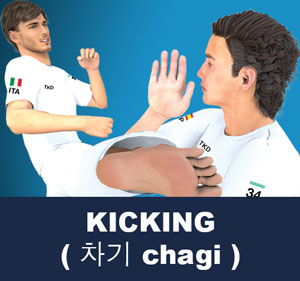
Kicking
( 차기 chagi )
Physically, taekwondo develops strength, speed, balance, flexibility, and stamina. An example of the union of mental and physical discipline is the breaking of wooden boards, bricks or tiles, which requires both physical mastery of the technique and the concentration to focus one's power.
A kick ( 차기 chagi ) is a physical strike using the foot, leg, or knee. Kicks as an act of human aggression have likely existed worldwide since prehistory ( View History of Kicks ). As the human leg is longer and stronger than the arm, kicks ( 차기 chagi ) are generally used to keep an opponent at a distance, surprise him or her with their range, and inflict substantial damage. On the other hand, stance ( 서기 sogi ) is very important in any combat system, and any attempt to deliver a kick ( 차기 chagi ) will necessarily compromise one's stability of stance ( 서기 sogi ).

The application of kicks ( 차기 chagi ) is thus a question of the tradeoff between the power that can be delivered vs the cost incurred to balance. Since combat situations are fluid, understanding this tradeoff and making the appropriate decision to adjust to each moment is key.
All kicks ( 차기 chagi ) can be executed as jump kicks, spin kicks, jump spin kicks or multi-rotational spin kicks. Also, all can be performed by the front or rear leg in a given stance. There are a variety of kicks ( 차기 chagi ) that can be used in combination or stem out from a simple kick to create more difficult ones. Some of these include 540 Kick (one spins 1½ times in mid-air and does a kick, usually a back spinning hook kick), a 720 Kick (one spins 2 times in mid-air and does a kick, usually a back spinning hook kick), and Triple Aero Kicks (one does round house kick, back spinning hook kick, and another round house kick in mid-air).
Also, many kicks ( 차기 chagi ) can be employed using a fast kick style. The practitioner shuffles the back leg forward to the front leg, and the front leg comes up and kicks closer to the enemy than the practitioner had been before execution. This can be used with side kick ( 옆차기 yeop-chagi ), roundhouse kick ( 돌려차기 dollyeo-chagi ), front kick ( 앞차기 ap-chagi ), hook kick ( 후려차기 huryeo-chagi ), and axe kick ( 내려차기 naeryeo-chagi ).
The utility of high kicks (above chest level) has been debated. Proponents have viewed that some high front snap kicks are effective for striking the face or throat, particularly against charging opponents, and flying kicks can be effective to scare off attackers. Martial arts systems that utilize high kicks also emphasize training of very efficient and technically perfected forms of kicks ( 차기 chagi ), include recovery techniques in the event of a miss or block, and will employ a wide repertoire of kicks ( 차기 chagi ) adapted to specific situations.
* Please see a certified Master Instructor ( 사범님 sabeomnim ) for training. Proper guidance and instructions are needed to ensure safe training.
FRONT KICK
( 앞차기 ap-chagi )
Difficulty Level: Beginner Tutorial Available
The Front Kick ( 앞차기 ap-chagi ) is one of the first kicks ( 차기 chagi ) learned in taekwondo, and if mastered it can become one of the most powerful kicks ( 차기 chagi ) in certain situations. The practitioner raises the knee ( 무릎 mureup ) to the waist, pulls the toes back and quickly extends the foot ( 발 bal ) at the target. Read more »

SIDE KICK
( 옆차기 yeop-chagi )
Difficulty Level: Beginner Tutorial Available
The Side Kick ( 옆차기 yeop-chagi ) is a beginner technique which is very powerful when done properly. The practitioner simultaneously raises the knee ( 무릎 mureup ) and rotates the body 90-degrees, while doing that they extend their leg to strike the opponent with most commonly the Foot Blade ( 발날 balnal ). The kick ( 차기 chagi ) is delivered sideways in relation to the body of the person kicking. Read more »
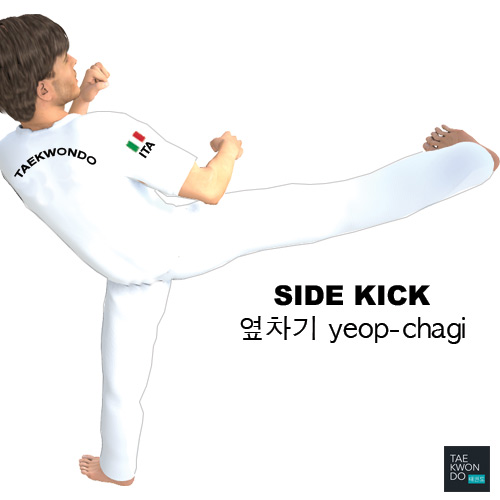
ROUNDHOUSE KICK
( 돌려차기 dollyeo-chagi )
Difficulty Level: Beginner Tutorial Available
The Roundhouse Kick ( 돌려차기 dollyeo-chagi ) is a beginner-intermediate level technique which is the most practiced kick ( 차기 chagi ) in the dojang ( 도장 ), and is the most familiar kick ( 차기 chagi ) in World Taekwondo (WT) tournaments. It requires the practitioner to raise their knee ( 무릎 mureup ) chambering, turn the hips, pivot on the non-kicking foot (standing foot), and then snap the kick ( 차기 chagi ) horizontally into the target at a 30 to 80-degree angle. Read more »

BACK KICK
( 뒤차기 dwi-chagi )
Difficulty Level: Intermediate Tutorial Available
The Back Kick ( 뒤차기 dwi-chagi ) is an intermediate technique typically introduced during yellow to green belt levels. The kick ( 차기 chagi ) is also referred to as a reverse spinning side kick, donkey kick, mule kick, or turning back kick. Here the practitioner turns the body away from the target and thrusts the back leg straight toward the target, hitting it with the bottom of the heel ( 뒤축 dwichuk ) while watching over the shoulder. Read more »
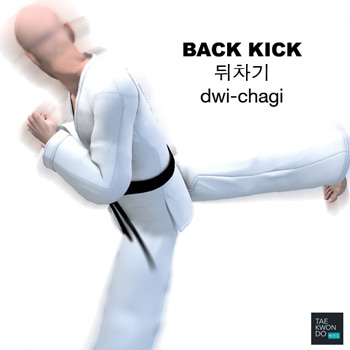
REVERSE SIDE KICK
( 반대 옆 차기 bandae-yeop-chagi )
Difficulty Level: Intermediate Tutorial Available
The Reverse Side Kick ( 반대 옆 차기 bandae-yeop-chagi ) is similar to the Back Kick ( 뒤차기 dwi-chagi ) by turning the body away from the target. Here the body turns further, allowing the foot blade ( 발날 balnal ) to hit the target with the foot ( 발 bal ) pointing to the side as in a regular Side Kick ( 옆차기 yeop-chagi ). Read more »
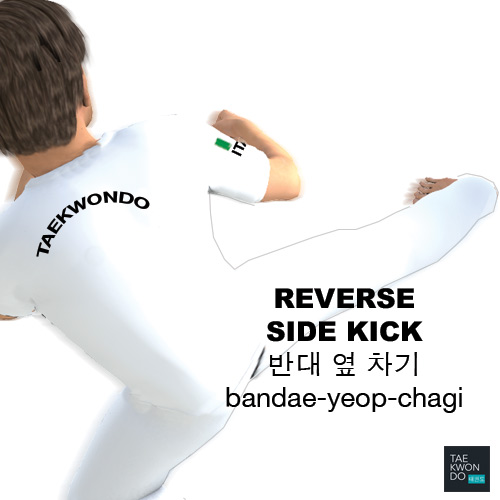
HOOK KICK
( 후려차기 huryeo-chagi )
Difficulty Level: Intermediate Tutorial Available
A less popular kick ( 차기 chagi ) traditionally, the Hook Kick ( 후려차기 huryeo-chagi ) has found increasing favour in modern taekwondo competitions. Once the kicking leg is at full extension, the knee ( 무릎 mureup ) is bent and the foot snapped to the side, impacting the target with most commonly the heel. Read more »
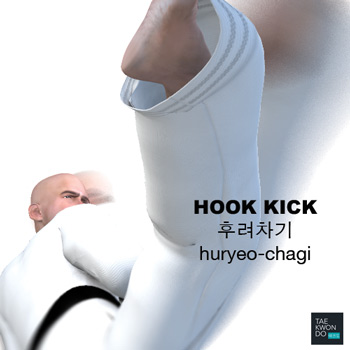
AXE KICK
( 내려차기 naeryeo-chagi )
Difficulty Level: Beginner Tutorial Available
The Axe Kick ( 내려차기 naeryeo-chagi ) is a beginner kick ( 차기 chagi ) that has increased in popularity due to taekwondo sparring ( 겨루기 gyeorugi ) competitions. The kick ( 차기 chagi ) is also known as a hammer kick, stretch kick, or thigh of obliteration kick because it is characterized by a straightened leg descending onto an opponent like the blade of an axe or like the motion of a hammer on a nail. Read more »
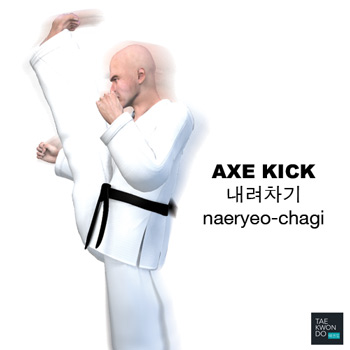
OUTWARD CRESCENT KICK
( 바깥차기 bakkat-chagi )
Difficulty Level: Intermediate Tutorial Available
The Outward Crescent Kick ( 바깥차기 bakkat-chagi ) is also referred to as a swing kick and has some similarities to an axe kick ( 내려차기 naeryeo-chagi ) with its upward raised leg. The practitioner raises the extended leg as high as possible, a bit across the centerline of the body from the inside, and then sweeps explosively outward in a circular arc movement hitting the target on the side. Read more »
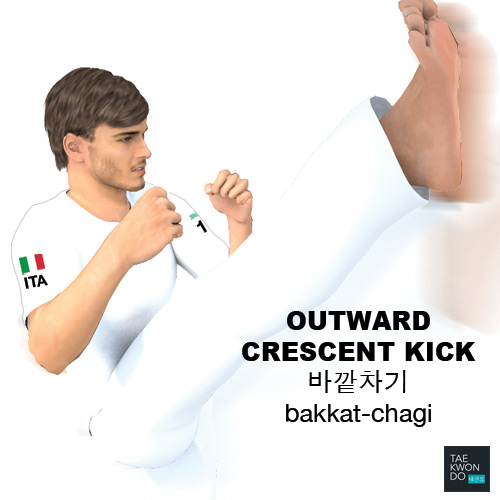
SPIN HOOK KICK
( 뒤후려차기 dwi-huryeo-chagi )
Difficulty Level: Advanced Tutorial Available
The Spin Hook Kick ( 뒤후려차기 dwi-huryeo-chagi ) is also known as a heel kick, back roundhouse kick, reverse turning kick, reverse round kick, spinning hook kick, spin kick, or wheel kick. This is a high-level advanced technique which is mainly used to strike the jaw area of an opponent, but is also highly effective in the temple region for a knockout attempt during tournament sparring ( 겨루기 gyeorugi ) Read more »
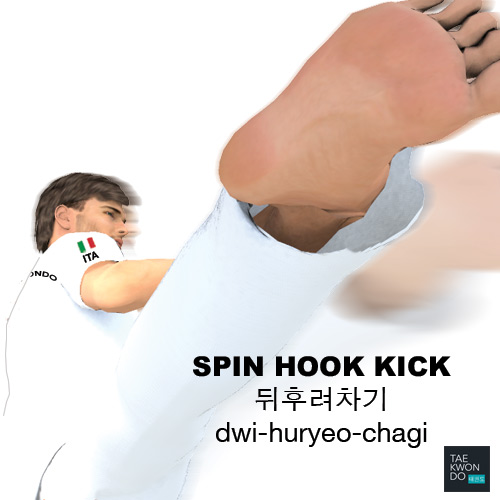
WHIRL KICK 360º / TORNADO KICK
( 360도 돌개차기 360º dolgae-chagi )
Difficulty Level: Intermediate Tutorial Available
The Whirl Kick 360º ( 360도 돌개차기 360º dolgae-chagi ) is an intermediate level technique also known as the Tornado Kick. The practitioner rotates the body in a 360º motion while floating in the air, and then performs a Roundhouse Kick ( 돌려차기 dollyeo-chagi ) or the Inward Crescent Kick ( 안차기 an-chagi ) in midair. Read more »

JUMP KICKS
( 뛰어차기 ttwieo-chagi )
Difficulty Level: Intermediate Tutorial Available
A jump kick or flying kick ( 뛰어차기 ttwieo-chagi ) is a type of kick ( 차기 chagi ) in taekwondo where the kick ( 차기 chagi ) is delivered while in the air moving forward into the opponent after a running start to gain forward momentum. Normally, jumping kicks involve pulling up the back leg to help gain height during the jump and then performing the kick itself with the front leg. Read more »
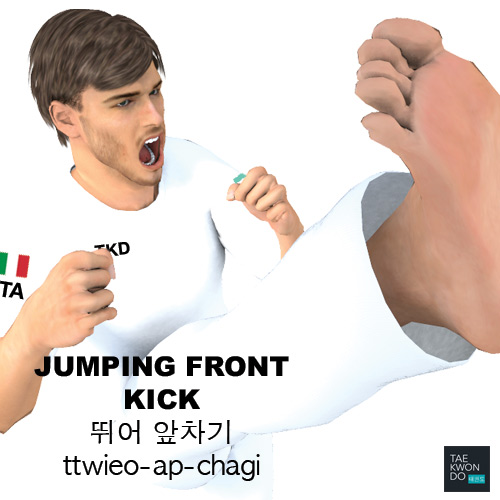
540º WHIRL KICK
( 540도 돌개차기 / 540º dolgae-chagi )
Difficulty Level: Advanced Tutorial Available
In martial arts and tricking, the 540 kick, also known as inside turning kick, jump inside kick, and tornado kick, is a jump kick move. It involves a rotation of approximately 540 degrees (although usually, when performed correctly, the performer has really only done a spin of 360 degrees not including whatever takeoff they used). Read more »
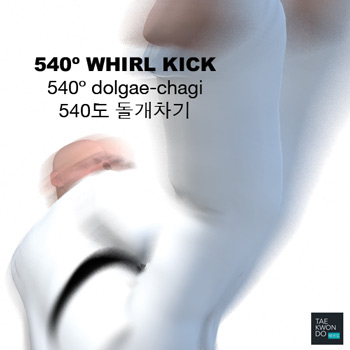
Risk of injury can be reduced by completing an effective warm up consisting of a heart raiser to get your pulse up, followed by sport specific dynamic stretches (stretches whilst moving). Please follow the guidance of a certified Master Instructor or trainer when doing sports related activities. Depending on the intensity of the exercise, cooling down can involve a slow jog or walk, or with lower intensities, stretching can be used. Cooling down allows the heart rate to return to its resting rate. View more information on Warming Up and Cooling Down ».
This article uses material from the Wikipedia articles "Warming Up" and "Cooling Down", which is released under the Creative Commons Attribution-Share-Alike License 3.0.
RESOURCES
This article uses material from the Wikipedia articles "List of Taekwondo Techniques", "Kick", and "540 Kick" which is released under the Creative Commons Attribution-Share-Alike License 3.0.




















